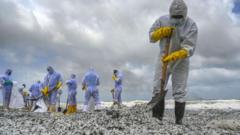Four years after the X-Press Pearl cargo ship disaster off the coast of Sri Lanka, the remnants of one of the largest plastic spills in history continue to haunt local beaches. Volunteers still spend countless hours sifting through sand, uncovering billions of plastic nurdles—tiny, toxic plastic pellets that have become a common sight along the shoreline.
The incident, which occurred in May 2021, involved the vessel leaking nitric acid while en route from Dubai to Malaysia. Despite signals of distress, the ship was denied permission to unload the hazardous cargo, resulting in a catastrophic fire that ultimately led to the vessel sinking. This disaster released not only the nurdles but an array of toxic materials, including engine fuel and heavy metals, into the maritime ecosystem.
Local environmentalists, such as Muditha Katuwawala, who heads the Pearl Protectors NGO, describe the scene as devastating. "It was horrifying—turtles and dolphins washing up with severe burns," he recalls. Thousands of volunteers began the cleanup, initially pulling hundreds of kilos of nurdles from the shore each day. Over time, however, their efforts dwindled as the pellets became harder to find, buried deeper in the sand.
Concern has emerged that the remaining nurdles are not merely remnants of the disaster but have transformed into hazardous pollutants, accumulating further toxins from the surrounding waters. "They appear to be like a chemical sponge," warns David Megson, an environmental scientist involved in ongoing research. Recent studies indicate that nurdles burned in the fire contain toxic metals such as arsenic and lead, highlighting an emerging risk to local marine life and, ultimately, communities that depend on fishing.
The agricultural and fishing sectors in Sri Lanka are bearing the brunt of these ecological impacts. Fishermen like Jude Sulanta lament the drastic decline in fish populations since the disaster, expressing fears about their future livelihoods. "Many are selling their boats and trying to go abroad,” he explains, revealing a community in crisis.
X-Press Feeders Ltd, the ship's owner, contends they have responded responsibly to the disaster, claiming to have spent over $130 million on cleanup efforts. However, Sri Lankan authorities argue this funding falls short of covering the extensive long-term damage. Legal measures are underway to negotiate further compensation, revealing ongoing tensions and conflicts surrounding responsibility.
Experts estimate the overall economic impact might exceed $6 billion when considering loss of marine life and harm to tourism. While the ship owner disputes these figures, the communities most affected continue to seek justice for the environmental disaster that resonates with deep-rooted implications for their culture and livelihoods.
As Sri Lanka's coastal ecosystems struggle to recover from this manmade disaster, the balance of nature and community life remains at stake, with many local residents contemplating their futures against a backdrop of uncertainty.




















